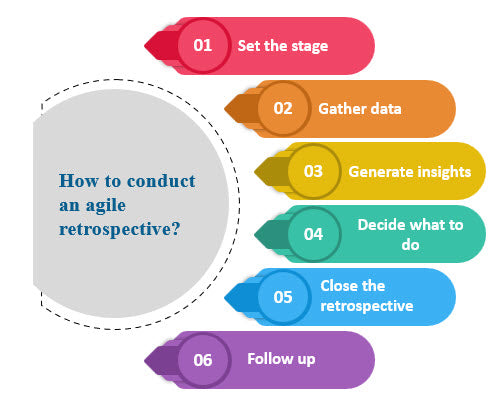How To Do a Retrospective in Agile: The Complete Guide
Retrospective agile is a key practice in the agile methodology that focuses on continuous improvement. It is a collaborative, time-boxed session where team members come together to reflect on the past iteration or sprint, identify areas for improvement and plan actionable steps to enhance their performance in subsequent sprints.
The retrospective agile process is an opportunity for the team to celebrate accomplishments, recognize challenges, and learn from past mistakes. Retrospectives help the team build better communication, foster a culture of trust, accountability, and transparency, and ultimately deliver better products. In this article, we will delve deeper into the benefits of retrospective agile, explore different retrospective formats, and provide tips for facilitating and conducting effective retrospectives.
What Is Agile Retrospective?
Agile retrospective is a meeting held by agile teams, typically at the end of a sprint, to reflect on their performance during that sprint and identify areas for improvement. The goal of the retrospective is to learn from the experience and make changes to the process to increase efficiency, effectiveness, and quality. The team members discuss what worked well, what did not work, and what changes they need to make in the future. The retrospective is a critical component of the agile process, allowing the team to continuously improve and adapt to changing conditions.
The team members discuss what worked well, what did not work, and what changes they need to make in the future. The retrospective is a critical component of the agile process, allowing the team to continuously improve and adapt to changing conditions.
Some Common Activities During an Agile Retrospective Include:
- Start-stop-continue: The team identifies what actions they should start doing, what they should stop doing, and what they should continue doing.
- Lean coffee: A structured discussion format where the team votes on which topics to discuss and then has a time-limited discussion around each topic.
- Appreciation and gratitude: A time to express gratitude for team members and celebrate successes.
- Fishbone diagram: A visual tool to identify the root cause of problems and brainstorm solutions.
- Timeline: A visualization of the sprint timeline to analyze where delays occurred and improve time management.
Why Is It Important For Small Businesses?
Retrospective agile is important for small businesses because it allows them to continuously improve their processes and adapt quickly to changing market conditions. By setting aside time to reflect on past work and identify areas for improvement, small businesses can make incremental changes that increase efficiency and productivity.
This can be especially important for smaller companies with limited resources, as even small improvements can have a significant impact on the bottom line. Retrospective agile also encourages open communication and collaboration within teams, fostering a culture of innovation and learning that can help small businesses stay competitive and agile in the face of disruption.
Additionally, retrospective agile provides a structured approach to problem-solving and decision-making, helping small businesses to address issues in a systematic and strategic manner. It allows teams to identify and address root causes of problems, rather than just treating symptoms. This can lead to more sustainable and effective solutions that can be implemented quickly.
Retrospective agile also promotes transparency and accountability within teams, as it encourages everyone to take ownership of the successes and failures of the project. This can empower team members to be more proactive and engaged in the process, as they have a clear understanding of what is expected of them and how their actions contribute to the overall success of the project.
Overall, retrospective agile is a valuable tool for small businesses looking to improve their processes, increase productivity, and stay competitive in the ever-changing business landscape. By fostering a culture of learning and continuous improvement, small businesses can adapt quickly to changing conditions and seize new opportunities as they arise.

What are some benefits of agile retrospective?
- Continuous Improvement: Agile retrospective provides an opportunity to improve processes and practices continuously. Teams can identify areas for improvement and take corrective measures.
- Team Collaboration: Retrospectives encourage open and honest communication within teams, which leads to better collaboration and trust.
- Increased Productivity: By identifying and addressing inefficiencies in the process, teams can become more productive and efficient.
- Positive Team Culture: Retrospectives can foster a positive team culture where everyone feels heard, valued, and supported.
- Positive Team Culture: Retrospectives can foster a positive team culture where everyone feels heard, valued, and supported.
- Better Performance: When teams are empowered, Collaborative, and productive, they are more likely to meet project deadlines and deliver high-quality products.
- Reduced Costs: Retrospectives can identify areas where teams are wasting time and resources, leading to cost savings.
- Improved Customer Satisfaction: By continuously improving processes, teams can deliver products that better meet customer needs and expectations.
How to conduct an agile retrospective?
- Set the stage: Create a positive and safe environment for the team members to provide feedback. State the purpose of the retrospective, establish ground rules, and choose a facilitator.
- Gather data: Collect information on the last iteration or sprint. This information can be in the form of metrics, feedback, issues, or concerns.
- Generate insights: Analyze the data to identify patterns and insights. Discuss what went well and what could be improved in the last iteration.
- Decide what to do: Brainstorm actions that can be taken to improve the team's performance in the next iteration. Use the insights generated in the previous step to prioritize actions and create an action plan.
- Close the retrospective: Summarize the outcomes of the retrospective, thank the team members for their participation, and evaluate the process.
- Follow up: Implement the action plan and track progress. Review the action plan in the next retrospective to assess the effectiveness of the actions taken.
Conclusion
In conclusion, the retrospective agile methodology is an essential part of an agile development process. It allows teams to reflect on their previous work, identify areas for improvement, and make changes to ensure better results in subsequent iterations. Retrospectives promote continuous learning, communication, and collaboration, which are fundamental to agile principles. As a result, teams can deliver high-quality, customer-focused products in a timely manner. If well-implemented, retrospective agile can lead to enhanced agility, efficiency, and productivity, and is well worth the investment in terms of time and effort.




